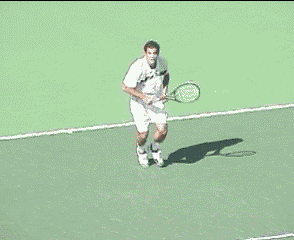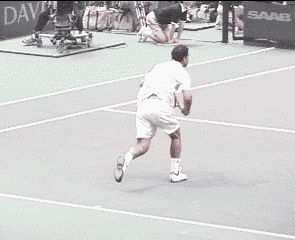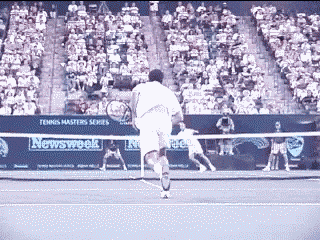|
TennisOne Lessons Roger Federer and the Forehand Volley Even the Best Can and Should Improve David Sammel There was little joy in my Australian Open prediction but tennis is an unforgiving and tough sport. I wrote before the open that four guys could win the tournament: Nadal, Murray, Federer, and Djokovic in that order. I put Nadal as favorite only because he has won five Slams and Murray has yet to win one. I also maintained that Nadal and Murray are in Federer's head and that it will be very difficult for Federer to beat either of them in a semi or a final. Therefore, it is not unreasonable to say that a possibility exists that Federer will not equal Sampras’s 14 Slams. There were two differences when Sampras came back to win the US Open after two years without a Slam win
I also predicted that unless Roger sorts out his footwork at the net, especially the footwork behind the forehand volley, he will struggle to win Number 14 because in my opinion he is unlikely to beat Rafa or Andy in a major again unless he can come forward with confidence. This does not detract from the great Champion that he is and the fight, character, and fantastic human qualities he possesses as a man. His tears were heartfelt and a measure of his love for tennis and his contribution to the game as part of a great rivalry. However tennis is a sport that measures the total package at any given time and ‘Fed’ is not addressing the weakness in his game, whereas Nadal has continued to pay the price physically and with a dedication to constant improvement - something that, because of all the success Federer has had, may have been blunted! I would love nothing better than Federer to come again with an improved net game and win Wimbledon but I fear that this issue has either not been spotted or that perhaps an unnecessary pride is preventing him from hiring the right person and doing the work to improve this area.
Having said all that, enormous credit must go to Rafa, another great Champion who is also on course to break the Sampras record and possibly Borg’s six French Open titles. Rafa has always had an incredible balance to his approach - fight hard every day and keep improving, win or lose, without letting disappointment ever cloud your objective of getting better. This is a key mental component for a tennis player because wanting to win is universal so the focus has to be on what it is that gives you the best chance to win, which is to fight to make every ball with better and better quality. My tip to all players is, with the right attitude, you never lose because after a loss, if you have competed with everything you could give then a loss will give you the next step to take in your improvement. Federer's Volley In the photo above, I find it amazing how poorly balanced Federer is, failing to step across behind his racquet. Instead he steps forward and hangs his racquet arm out struggling to reach an easy volley. He now has to rely on hand skills alone and without his body weight behind the ball has very limited power, so a put-away becomes an average volley giving Andy a comfortable second bite of the cherry. In the video of the full point (below), further damage is seen when the left leg is forced to swing behind the right to regain balance, leading to slow recovery, a late split, and therefore poor positioning before the next volley. This forces him to guess where the pass will go and he does not reach the easy put-away.
Federer's poor movement and footwork on the forehand volley hurts him at the net and puts pressure on the short forehand. When a match is tight, he sometimes slaps and misses this shot perhaps because he feels pressure to play a bigger approach shot to get an easier volley or a free point. He seems nervous moving forward because working a point at the net is uncomfortable for him and his confidence is lower at the net.
If we compare Federer’s footwork to that of Sampras it is very clear. Above you can see how Pete's left leg steps out at a 45º angle behind his racquet and the ball in almost a carbon copy of the Federer volley versus Murray above. In the clip below of Sampras playing a forehand volley down the line (below) you can see the diagonal step forward but also how well his body weight continues behind the volley with another step and full commitment following the line of the ball after the volley.
Key points to help improve your volley from these observations from club level to the pros:
Common errors for club players to be aware of are:
You can find many Federer forehand volleys that show this problem. In my opinion, Sampras would have been a harder nut for Nadal to crack on grass and hard courts, given his outstanding movement to and at the net. Surprisingly Murray may have found Sampras easier to cope with given his early returns and may have enjoyed the target Sampras presented, but that is another debate. For now let’s see if Federer sorts this out or continues to believe if he serves better he will win as he has indicated in the aftermath of Australia. There is a real issue with the Federer forehand volley and subsequently his reliance on hand skills makes him vulnerable at the net and reluctant to go forward when it is tight. Add this to the ability of Murray and Nadal to make Roger play so many backhands, Murray because of his early backhand cross and Nadal with the height and jump on his cross-court forehand, give Federer a tough problem to solve. If Federer plays his backhand down the line and gets the shorter forehand he has to be comfortable approaching the net with the down the line forehand. If he commits to sorting his forehand volley and improving his footwork at the net, then I do believe he will be in the hunt for a few more Slams.
Recruited as a top 10 junior from
Visit David's websites mctacademy and tennis4everyone. |




